Action plan after your local Cardiologist visit
Action plan after your local Cardiologist visit
Blog Article
Comprehending the Value of Cardiology in Modern Healthcare Solutions
Cardiology plays a critical duty in contemporary healthcare, specifically as heart disease continues to be the leading root cause of mortality worldwide. Advancements in diagnostics and treatment have actually changed client care, enabling earlier treatments and enhanced outcomes. The change towards preventative cardiology empowers people to handle their wellness proactively. As innovation continues to evolve, the combination of innovative remedies might better redefine cardiology's influence on public health and wellness, motivating a more detailed exam of arising trends and their implications.
The Frequency of Heart Condition and Its Effect On Public Health And Wellness
Although cardiovascular disease stays the leading cause of fatality globally, its influence expands much beyond individual people to affect public wellness systems and economic climates. The high frequency of heart problem puts a significant pressure on healthcare resources, necessitating boosted funding for avoidance, treatment, and recovery programs. Public health campaigns need to attend to threat elements such as weight problems, smoking, and sedentary way of lives, which contribute considerably to the increasing incidence of heart conditions.Moreover, the economic worry linked with heart condition is tremendous, including not only straight medical costs but also indirect expenses associated with shed productivity and early mortality. Neighborhoods deal with obstacles in handling these costs, frequently leading to differences in health care accessibility and results. As the population ages and lifestyle-related threats continue to intensify, the necessity for reliable cardiology interventions comes to be vital. Addressing heart condition is not only a matter of specific health and wellness yet also a critical public health and wellness top priority.
Developments in Cardiac Diagnostics and Imaging Techniques
Recent innovations in cardiac diagnostics and imaging strategies have actually transformed the area of cardiology, boosting the capability to find and keep an eye on heart conditions. Strategies such as cardiac MRI, CT angiography, and echocardiography have become significantly sophisticated, giving in-depth pictures of heart structures and features. These modalities enable for the very early identification of conditions like coronary artery illness, cardiac arrest, and valvular disorders.Moreover, advancements in non-invasive diagnostics, such as wearable innovation and remote monitoring gadgets, have actually equipped people and doctor. These tools facilitate real-time tracking of heart rhythms and various other essential indications, leading to timely treatments. In addition, man-made knowledge is being integrated right into imaging analysis, improving precision and efficiency in diagnosis.
Innovations in Therapy Alternatives for Heart Issues
Recent innovations in cardiology have actually resulted in substantial developments in therapy alternatives for heart problems. These consist of sophisticated medical methods that enhance procedural outcomes and arising medicines that use brand-new opportunities for therapy. As the area advances, these technologies play a vital function in boosting client treatment and results.
Advanced Surgical Techniques
Developments in medical methods have changed the landscape of cardiology, providing brand-new expect patients with heart disease. Minimally invasive procedures, such as catheter-based treatments, have actually considerably minimized healing times and hospital remains. Strategies like robotic-assisted surgical treatment boost precision, allowing specialists to navigate complicated physiological frameworks with better accuracy. Moreover, improvements in imaging technology assist in real-time visualization throughout procedures, boosting outcomes. Transcatheter aortic valve substitute (TAVR) exemplifies a breakthrough in treating aortic constriction, making it possible for valve replacement without open-heart surgical procedure. Furthermore, hybrid strategies that combine medical and catheter-based techniques provide customized services for numerous cardiac problems. These sophisticated surgical methods not only enhance client safety and security but likewise broaden treatment choices, underscoring the crucial role of innovation in contemporary cardiology practices.
Arising Medicines and Treatments
As the landscape of cardiology remains to advance, arising medicines and therapies play a critical role in enhancing therapy options for heart disease. Developments such as novel anticoagulants and progressed lipid-lowering agents have changed the management of cardio conditions, significantly reducing person morbidity and death. Furthermore, the growth of gene treatments and regenerative medication supplies promising opportunities for dealing with problems previously considered incurable. Professional trials are consistently exposing the efficiency of these therapies, pressing the borders of traditional therapies. Moreover, the combination of digital health and wellness innovations facilitates tailored medicine, enabling customized treatment plans based on genetic and way of life aspects. Jointly, these advancements highlight the dynamic nature of cardiology, boosting patient results and redefining standards of care in modern-day health care.
The Duty of Preventive Cardiology in Client Treatment
Precautionary cardiology plays a vital duty in client treatment by concentrating on the identification of threat variables that add to heart illness. With way of living adjustment approaches and very early discovery techniques, health care providers can effectively lower the occurrence of cardio events - Dr Garcia. This proactive strategy not only boosts client outcomes but also advertises long-term wellness
Risk Aspect Recognition
While cardiovascular diseases stay a leading source of morbidity and death worldwide, efficient danger variable recognition functions as a keystone of preventative cardiology. Determining danger elements such as hypertension, household, hyperlipidemia, and diabetes history is crucial for very early treatment. Healthcare experts use numerous evaluating approaches to review these variables, enabling tailored safety nets. Additionally, recognizing an individual's way of living choices, such as smoking and physical inactivity, better informs danger analyses. This detailed examination enables clinicians to develop personalized care strategies intended at mitigating threats. By prioritizing risk aspect recognition, health care systems can enhance client end results and decrease the general problem of cardiovascular illness, ultimately adding to enhanced public health and wellness techniques and resource allowance.
Lifestyle Modification Methods
A wide range of research studies highlights the important role of way of living adjustment techniques in reducing cardio disease danger. These methods incorporate nutritional changes, enhanced physical task, smoking cigarettes cessation, and weight management. By adopting a heart-healthy diet plan abundant in fruits, veggies, entire grains, and lean healthy proteins, people can lower cholesterol levels and high blood pressure. Normal exercise enhances the heart and enhances overall cardiovascular health and wellness. In addition, stopping smoking significantly lowers the danger of heart condition and improves healing prices for those with present conditions. Weight administration additionally adds to cardio health by mitigating various other risk factors such as diabetic issues and high blood pressure. Applying these way of life transforms not just promotes my sources private wellness yet also functions as a foundation of preventive cardiology in individual care.
Very Early Detection Techniques
Way of living adjustments greatly add to reducing heart disease threats, but they are most efficient when matched with early detection techniques. Precautionary cardiology emphasizes the relevance of identifying possible heart issues prior to they intensify into severe conditions. Strategies such as blood stress monitoring, cholesterol testing, and advanced imaging technologies like echocardiograms play important functions in evaluating cardiovascular wellness. Biomarkers and hereditary screening also enhance the accuracy of very early detection, permitting tailored preventive approaches. Regular heart threat analyses equip doctor to interfere proactively, potentially avoiding cardiac arrest and strokes (Cardiology Jupiter). By incorporating these early detection approaches right into routine treatment, patients can gain from timely lifestyle interventions and targeted therapies, eventually boosting outcomes and enhancing lifestyle
Integrating Modern Technology Into Cardiology Practices
As developments in innovation remain to improve numerous areas, the assimilation of cutting-edge devices and systems into cardiology practices has ended up being important for improving individual treatment and outcomes. Telemedicine platforms allow cardiologists to check patients remotely, improving accessibility to care while reducing the concern on medical care facilities. Wearable gadgets, such as smartwatches, make it possible for continual heart price tracking, informing both medical professionals and clients to possible issues in real-time. Additionally, expert system (AI) is being made use of to evaluate vast amounts of heart information, assisting in very early diagnosis and personalized therapy plans. Advanced imaging techniques, consisting of 3D echocardiography, improve visualization of heart structures, leading to more accurate treatments. Electronic wellness records (EHRs) streamline person details administration, making sure that cardiologists have immediate accessibility to vital data. With each other, these technical advancements are changing cardiology, promoting aggressive administration and improved health and wellness outcomes for people with cardiovascular problems.
The Significance of Individual Education And Learning and Engagement
Client education and learning and engagement play an essential duty in the monitoring read what he said of cardiovascular health and wellness. By outfitting patients with understanding concerning their conditions, therapy choices, and way of living adjustments, healthcare suppliers empower people to take an active role in their care. This positive method can result in improved adherence to prescribed drugs, nutritional modifications, and exercise regimens, inevitably reducing the threat of complications.Engagement additionally promotes a strong patient-provider partnership, encouraging open communication and trust fund. When people really feel educated and involved, they are most likely to voice issues and ask concerns, which can lead to much better professional end results. Additionally, instructional sources, such as workshops or digital systems, can boost understanding and advertise self-management strategies. Overall, focusing on individual education and interaction is necessary for improving cardiovascular wellness, enhancing lifestyle, and reducing health care expenses related to heart diseases.
Future Fads in Cardiology and Their Potential Effect

Frequently Asked Concerns
What Way Of Living Adjustments Can Decrease Cardiovascular Disease Danger?
The existing concern addresses way of life adjustments that can significantly lower heart problem danger. Cardiology care. Adopting a balanced diet regimen, involving in routine exercise, maintaining a healthy weight, taking care of anxiety, and avoiding tobacco can notably improve cardiovascular wellness
Just How Can I Recognize Very Early Signs of Heart Issues?
Identifying early indicators of heart problems includes monitoring symptoms such as breast discomfort, lack of breath, fatigue, and uneven heart beat. Prompt understanding of these signs can trigger essential medical evaluation and intervention for much better end results.
What Are the Distinctions In Between Cardiologists and Heart Surgeons?
The distinctions in between cardiologists and cardiac specialists hinge on their functions; cardiologists largely manage and diagnose heart problems through non-invasive techniques, while heart website here doctors carry out operations to correct structural heart concerns. Each plays an important, distinctive role.

How Frequently Should I Obtain My Heart Health Checked?
The frequency of heart checkup varies based on individual risk factors. Usually, grownups ought to undergo analyses each to 2 years, while those with present conditions might need even more regular assessments as recommended by health care specialists.
What Role Does Genetics Play in Cardiovascular Disease Danger?
Genes considerably influences cardiovascular disease risk, with familial patterns suggesting inherited conditions. Specific genetics can predispose individuals to hypertension, cholesterol issues, and other cardio problems, highlighting the value of genetic screening in evaluating heart health. Heart illness remains the leading reason of fatality globally, its influence prolongs much past specific patients to impact public wellness systems and economies. Public health and wellness campaigns should resolve risk elements such as weight problems, smoking cigarettes, and sedentary way of lives, which add greatly to the increasing occurrence of heart conditions.Moreover, the economic problem linked with heart condition is immense, including not just direct medical prices however additionally indirect costs connected to shed productivity and early mortality. Precautionary cardiology plays an important duty in client care by concentrating on the recognition of risk elements that add to heart disease. Synthetic knowledge (AI) and equipment understanding are boosting diagnostics and individual surveillance, making it possible for early detection of heart illness. The differences between cardiologists and heart cosmetic surgeons exist in their roles; cardiologists primarily identify and handle heart conditions with non-invasive methods, while heart specialists do medical procedures to correct architectural heart issues.
Report this page